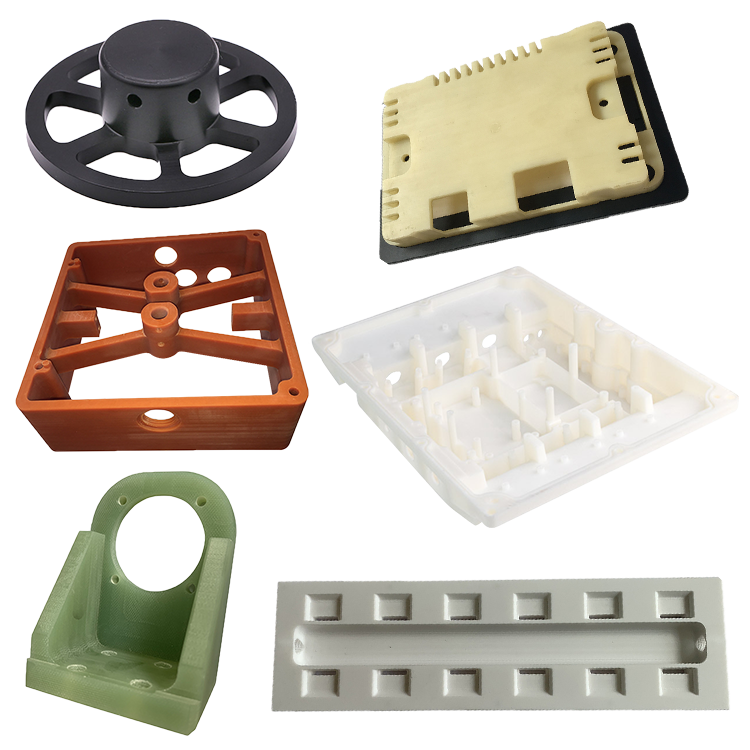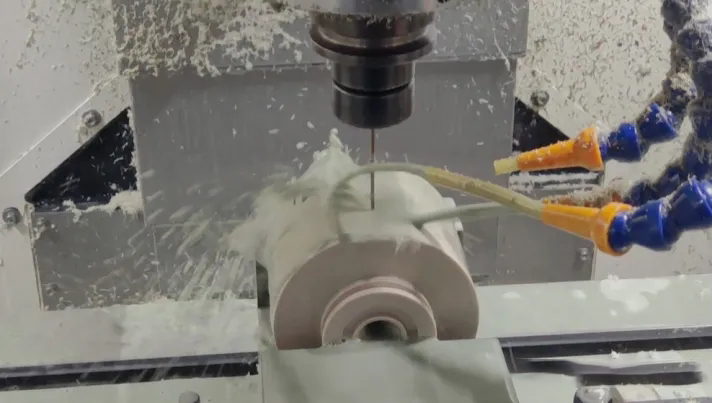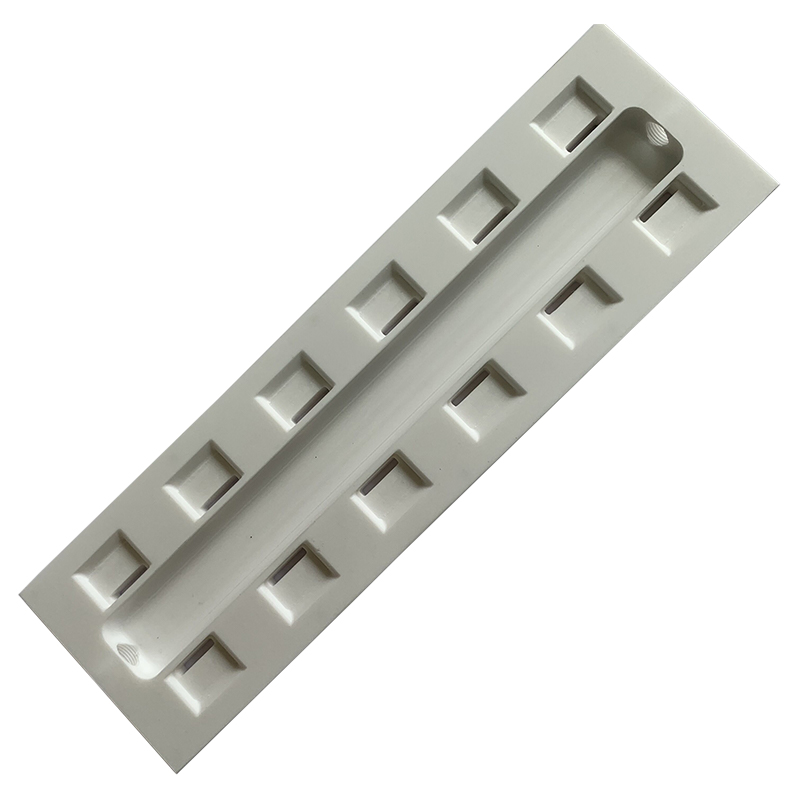What is PEEK plastic?
PEEK plastic, also known as polyether ether ketone, is a semi-crystalline, high-performance thermoplastic material characterized by excellent mechanical properties and excellent dimensional stability, which can work continuously at temperatures up to 250°C, and also has High chemical resistance, however certain acids such as sulfuric acid will dissolve the material. PEEK plastic is available in block, rod, powder or granule form. Due to its properties, many CNC parts made from PEEK are widely used in medical, aerospace, semiconductor, oil, gas, automotive, structural, high-temperature electrical, and biomedical applications.

What are the properties and characteristics of PEEK plastic?
- Easy to manufacture and process
- Excellent dimensional stability
- High heat resistance and stability
- Excellent mechanical properties and toughnes
- Excellent chemical resistance
- Good wear resistance and sliding properties
- Strong radiation resistance
- High purity and low outgassing
What is PEEK CNC machining?
PEEK plastic CNC machine tools are the most common type of PEEK processing. CNC, that is, computer numerical control, is the automatic control of processing tools by computers. CNC machines process materials by following coded program instructions rather than manual operators. PEEK CNC machining is popular because it is the most efficient and economical option for rapid production of prototypes and plastic models. An automated CNC machine is controlled by a computer that determines the path of the machine’s tooling based on the 3D files created. CNC machining does not require tooling, thus reducing start-up time and costs. Ideal for CNC machining plastic parts larger than 600 mm.

Application of PEEK Plastic CNC Machining Parts:
Electronics industry: insulators, connectors and wafer carriers;
Mechanical engineering: gears, sliding elements, compressor and pump components, drives, bushings, valves and rollers;
Automotive industry: Clutch and gearbox components as well as turbocharger wheels;
Conveyor technology: guide rails, belts, rollers, grippers and valves;
Medical industry: components for surgical instruments and short-term implants;
Food industry: valves, mixers, demoulding machines, batching systems and kneaders;
Oil and Gas Industry: Drill Bits, Seals and Sensors.
Why choose PEEK plastic material?
The long-term use temperature of parts made of high-temperature plastic PEEK can reach 260°C, and its melting point is about 341°C. Often used in hot water or steam environments, PEEK plastic maintains high levels of physical properties such as flexural strength and tensile strength. The added value brought by PEEK material – it can be used to make parts with lighter weight, higher strength and longer service life in harsh environments.

PEEK plastic CNC machining and manufacturing process:
PEEK plastic can be manufactured through two different CNC machining processes: PEEK injection molding or PEEK CNC machining.
CNC machining is a commonly used method for CNC machining PEEK, but the skills that need to be paid attention to during CNC machining.
PEEK is a processable thermoplastic, but important steps must be taken before, during and after processing to provide an optimal end product.
Annealing
Annealing is a process performed on PEEK rods to relieve stress and reduce stress and the possibility of surface cracking of the PEEK material during processing. Annealed PEEK is also less likely to deform. Depending on the time required for processing, multiple annealing stages may be required.
Cutting Tool
In most cases, silicon carbide tools can be used for CNC machining PEEK. If PEEK is reinforced with carbon fibers, or if particularly tight tolerances are required, diamond tools should be used. It also prevents contamination if the cutting tool used is not intended for metal.
Cool Down
PEEK does not release heat and must be cooled during CNC machining to prevent deformation and cracking. With the exception of medical components, standard liquid coolants can be used. For medical components, PEEK materials must be cooled with compressed air because liquid coolants can affect the biocompatibility of PEEK.
Drilling
PEEK is less stretchable than other plastics, so deep drilling can cause cracks.
Things to pay attention to in PEEK CNC machining
The diversity of engineering applications requires materials that can perform optimally over a wide range of temperature conditions. Polyetheretherketone (PEEK) is one such material that, in addition to its good properties at high temperatures and over a wide temperature range, also has the advantage of being a lightweight polymer.
Usually manufactured by stepwise polymerization, PEEK is more expensive compared to other polymers but offers excellent properties in multiple dimensions. PEEK has excellent wear and abrasion resistance and is required in several engineering fields. CNC (Computer Numerically Controlled) machining consists of multi-axis milling, turning and different variants of electrical discharge machines (EDM) to obtain the desired geometrical profile. The main advantage of these machines is the ability to control the machine through computer-generated code through an advanced controller.
CNC machining offers the opportunity to create complex geometries while meeting the geometric tolerance requirements of different materials, from plastics to metals. Mold PEEK material can be machined to obtain complex geometric profiles. Medical and industrial grade PEEK can be processed. PEEK CNC machining offers high precision and repeatability.
Due to PEEK’s high melting point, faster feed rates and speeds can be employed during CNC machining compared to other polymers. Before starting the CNC machining process, special annealing requirements must be met to avoid internal stress and heat-related cracks during the CNC machining process. These requirements vary according to the grade of PEEK material used and full details on this are provided by the manufacturer of that grade.
PEEK is stronger and harder than most polymers, but softer than most metals. This requires the use of fixtures during machining to ensure precise machining. PEEK is a high heat engineering plastic and cannot sufficiently dissipate the heat generated during CNC machining. This requires techniques to avoid problems caused by inefficient heat dissipation from the material. These preventative measures include peck drilling, coolant feeding the drill bit, and using adequate coolant in all CNC machining processes. Both petroleum-based and water-based coolants can be used.
Another important factor to consider when machining the few other compatible plastics is tool wear during PEEK machining. Using carbon fiber reinforced PEEK grades is more detrimental to the tooling. This requires the use of carbide tools for normal grades of PEEK and diamond tools for carbon fiber reinforced PEEK grades. The use of coolant also improves tool life.

The above is the knowledge of PEEK plastic CNC machining parts, I hope it will be helpful to you.